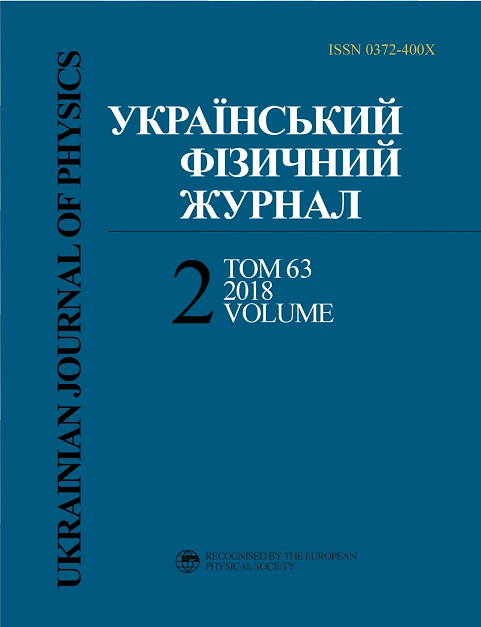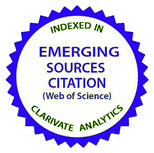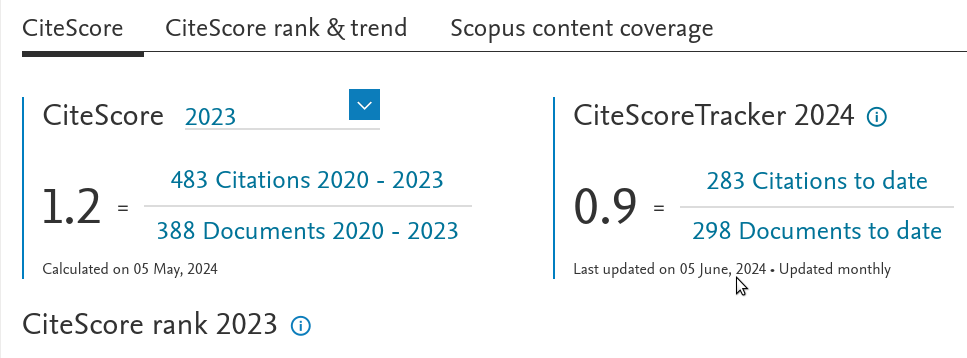Ступінь димеризації, ефективна поляризовність молекул і теплоємність насиченої водяної пари
DOI:
https://doi.org/10.15407/ujpe63.2.121Ключові слова:
насичена водяна пара, ефективна поляризовнiсть, теплоємнiсть при постiйному об’ємiАнотація
Робота присвячена дослiдженню властивостей водяної пари. Основна увага зосереджена на фiзичнiй природi її ефективної поляризовностi та теплоємностi при постiйному об’ємi. Встановлено, що специфiчнi температурнi залежностi цих характеристик зумовленi головним чином тепловими коливаннями димерiв води. У зв’язку з цим визначено нормальнi координати для коливань димера. Детально дослiдженi коливання дипольних моментiв димерiв та розглянуто їх внесок у дiелектричну проникнiсть водяної пари. Також враховано внесок мiжчастинкової взаємодiї до теплоємностi водяної пари. Аналiзуючи поведiнку ефективної поляризовностi та теплоємностi, визначено температурну залежнiсть концентрацiї димерiв вздовж лiнiї спiвiснування рiдина-пара. Помiтна димеризацiя в насиченiй водянiй парi вiдбувається лише за температури T/Tc > 0,8 (де Tc – критична температура). Важливо зазначити, що успiшне вiдтворення ефективної поляризовностi та теплоємностi може служити хорошим випробуванням для правильного опису концентрацiї димерiв в рiзних пiдходах.
Посилання
</li>
<li>K. Burrows, E.R. Pike, J.M. Vaughan. Light-scattering experiments on water vapour at pressures approaching saturation. Nature 260, 131 (1976).
<a href="https://doi.org/10.1038/260131a0">https://doi.org/10.1038/260131a0</a>
</li>
<li>G.E. Ashwell, P.A. Eggett, R. Emery, H.A. Gebbie. Molecular complexity of water vapour and the speed of sound. Nature 247, 196 (1974).
<a href="https://doi.org/10.1038/247196a0">https://doi.org/10.1038/247196a0</a>
</li>
<li>L. A. Curtiss, D. J. Frurip, M. J. Blander. Studies of molecular association in H2O and D2O vapors by measurement of thermal conductivity. Chem. Phys. 71, 2703 (1979).
<a href="https://doi.org/10.1063/1.438628">https://doi.org/10.1063/1.438628</a>
</li>
<li>R.A. Bohlander, H.A. Gebbie, G.W.F. Pardoe. Absorption spectrum of water vapor in the region of 23 cm?1 at low temperatures. Nature 228, 156 (1970).
<a href="https://doi.org/10.1038/228156a0">https://doi.org/10.1038/228156a0</a>
</li>
<li>J. Hargrove. Water dimer absorption of visible light. Atmos. Chem. Phys. Discuss. 7, 11123 (2007).
<a href="https://doi.org/10.5194/acpd-7-11123-2007">https://doi.org/10.5194/acpd-7-11123-2007</a>
</li>
<li>A.J.L. Shillings, S.M. Ball, M.J. Barber, J. Tennyson, R.L. Jones. An upper limit for water dimer absorption in the 750 nm spectral region and a revised water line list. Atmos. Chem. Phys. 11, 4273 (2011).
<a href="https://doi.org/10.5194/acp-11-4273-2011">https://doi.org/10.5194/acp-11-4273-2011</a>
</li>
<li>A.A. Vigasin. Water vapor continuous absorption in various mixtures: possible role of weakly bound complexes. J. Quant. Spectr. Rad. Transf. 64, 25 (2000).
<a href="https://doi.org/10.1016/S0022-4073(98)00142-3">https://doi.org/10.1016/S0022-4073(98)00142-3</a>
</li>
<li>A.A. Vigasin, A.I. Pavlyuchko, Y. Jin, S. Ikawa. Density evolution of absorption bandshapes in the water vapor OH-stretching fundamental and overtone: evidence for molecular aggregation. J. Mol. Str. 742, 173 (2005).
<a href="https://doi.org/10.1016/j.molstruc.2004.12.060">https://doi.org/10.1016/j.molstruc.2004.12.060</a>
</li>
<li> C.J. Leforestier.Water dimer equilibrium constant calculation: A quantum formulation including metastable states. Chem. Phys. 140, 074106 (2014).
<a href="https://doi.org/10.1063/1.4865339">https://doi.org/10.1063/1.4865339</a>
</li>
<li> J.O. Hirschfelder, F.T. McClure, I.F. Weeks. Second virial coefficients and the forces between complex molecules. J. Chem. Phys. 10, 201 (1942).
<a href="https://doi.org/10.1063/1.1723708">https://doi.org/10.1063/1.1723708</a>
</li>
<li> D. Stogrynt, J.O. Hirschfelder. Contribution of bound, metastable, and free molecules to the second virial coefficient and some properties of double molecules. J. Chem. Phys. 31, 6, 1531 (1959).
</li>
<li> G. N.I. Clark, D.C. Christopher, J.D. Smith, R.J. Saykally. The structure of ambient water. Mol. Phys. 108, 1415 (2010).
<a href="https://doi.org/10.1080/00268971003762134">https://doi.org/10.1080/00268971003762134</a>
</li>
<li> Y. Scribano, N. Goldman, R.J. Saykally. Water dimers in the atmosphere III: Equilibrium constant from a flexible potential. J. Phys. Chem. A 110, 5411 (2006).
<a href="https://doi.org/10.1021/jp056759k">https://doi.org/10.1021/jp056759k</a>
</li>
<li> N.P. Malomuzh, V.N. Makhlaichuk, S.V. Hrapatiy. Water dimer dipole moment. Russ. J. Phys. Chem. A 88, 1431 (2014).
<a href="https://doi.org/10.1134/S0036024414080172">https://doi.org/10.1134/S0036024414080172</a>
</li>
<li> J.R. Reimers, R.O. Watts. The structure and vibrational spectra of small clusters of water molecules. Chem. Phys. 85, 83 (1984).
<a href="https://doi.org/10.1016/S0301-0104(84)85175-7">https://doi.org/10.1016/S0301-0104(84)85175-7</a>
</li>
<li> H.J.C. Berendsen, J.P.M. Postma, W.F. van Gunsteren, J. Hermans. In Intermolecular Forces. Edited by B. Pullman (Reidel, 1981), p. XXXXXX.
</li>
<li> M.J. Smit, G.C. Groenenboom, P.E.S.Wormer, Ad van der Avoird, R. Bukowski, K. Szalewicz. Vibrations, tunneling, and transition dipole moments in the water dimer. J. Phys. Chem. A 105, 6212 (2001).
<a href="https://doi.org/10.1021/jp004609y">https://doi.org/10.1021/jp004609y</a>
</li>
<li> H. Fr?ohlich. Theory of Dielectrics: Dielectric Constant and Dielectric Loss (Clarendon, 1958).
</li>
<li> V.L. Kulinskii, N.P. Malomuzh. Dipole fluid as a basic model for the equation of state of ionic liquids in the vicinity of their critical point. Phys. Rev. E 67, 011501 (2003).
<a href="https://doi.org/10.1103/PhysRevE.67.011501">https://doi.org/10.1103/PhysRevE.67.011501</a>
</li>
<li> D.P. Fernandez, Y. Mulev, A.R.H. Goodwin, J.M.H. Levelt Sengers. A database for the static dielectric constant of water and steam. J. Phys. Chem. Ref. Data 24, 133 (1995).
<a href="https://doi.org/10.1063/1.555977">https://doi.org/10.1063/1.555977</a>
</li>
<li> N.P. Malomuzh, V.N. Mahlaichuk, S.V. Hrapatiy. Water dimer equilibrium constant of saturated vapor. Russ. J. Phys. Chem. A 88, 1287 (2014).
<a href="https://doi.org/10.1134/S003602441406017X">https://doi.org/10.1134/S003602441406017X</a>
</li>
<li> N.P. Malomuzh, V.N. Makhlaichuk, P.V. Makhlaichuk, K.N. Pankratov. Cluster structure of water in accordance with the data on dielectric permittivity and heat capacity. J. Struct. Chem. 54, 205 (2013).
<a href="https://doi.org/10.1134/S0022476613080039">https://doi.org/10.1134/S0022476613080039</a>
</li>
<li> A.I. Fisenko, N.P. Malomuzh, A.V. Oleynik. To what extent are thermodynamic properties of water argon-like? Chem. Phys. Lett. 450, 297 (2008).
<a href="https://doi.org/10.1016/j.cplett.2007.11.036">https://doi.org/10.1016/j.cplett.2007.11.036</a>
</li>
<li> L.A. Bulavin, A.I. Fisenko, N.P. Malomuzh. Surprising properties of the kinematic shear viscosity of water. Chem. Phys. Lett. 453, 183 (2008).
<a href="https://doi.org/10.1016/j.cplett.2008.01.028">https://doi.org/10.1016/j.cplett.2008.01.028</a>
</li>
<li> L.A. Bulavin, T.V. Lokotosh, N.P. Malomuzh. Role of the collective self-diffusion in water and other liquids. J. Mol. Liq. 137, 1 (2008).
<a href="https://doi.org/10.1016/j.molliq.2007.05.003">https://doi.org/10.1016/j.molliq.2007.05.003</a>
</li>
<li> E.W. Lemmon, M.O. McLinden, D.G. Friend. Thermophysical properties of fluid systems. In NIST Chemistry WebBook, NIST Standard Reference Database Number 69. Edited by P.J. Linstrom and W.G. Mallard (National Institute of Standards and Technology, XXXX).
</li>
<li> L.D. Landau, E.M. Lifshitz. Statistical Physics (Pergamon, 1980).
</li>
<li> M.V. Timofeev. Simulation of the interaction potential between water molecules. Ukr. J. Phys. 61, 893 (2016).
<a href="https://doi.org/10.15407/ujpe61.10.0893">https://doi.org/10.15407/ujpe61.10.0893</a>
</li>
<li> J.O. Hirschfelder, Ch.F. Curtiss, R.B. Bird. Molecular Theory of Gases and Liquids (Wiley, 1954).
</li>
<li> S.V. Lishchuk, N.P. Malomuzh, P.V. Mahlaichuk. Why thermodynamic properties of normal and heavy water are similar to those of argon-like liquids? Phys. Lett. A 374, 2084 (2010).
<a href="https://doi.org/10.1016/j.physleta.2010.02.070">https://doi.org/10.1016/j.physleta.2010.02.070</a>
</li>
<li> A.H. Harvey, E.W. Lemmon. Correlation for the second virial coefficient of water. J. Phys. Chem. Ref. Data 33, 369 (2004).
<a href="https://doi.org/10.1063/1.1587731">https://doi.org/10.1063/1.1587731</a>
</li>
<li> G.T. Evans, V. Vaida. Aggregation of water molecules: Atmospheric implications. J. Chem. Phys. 113, 6652 (2000).
<a href="https://doi.org/10.1063/1.1310601">https://doi.org/10.1063/1.1310601</a>
</li>
<li> Y. Scribano, N. Goldman, R.J. Saykally, C. Leforestier. Water dimers in the atmosphere III: Equilibrium constant from a flexible potential. J. Phys. Chem. A 110, 5411 (2006).
<a href="https://doi.org/10.1021/jp056759k">https://doi.org/10.1021/jp056759k</a>
</li>
<li> M.Yu. Tretyakov, D.S. Makarov. Some consequences of high temperature water vapor spectroscopy: Water dimer at equilibrium. J. Chem. Phys. 134, 084306 (2011).
<a href="https://doi.org/10.1063/1.3556606">https://doi.org/10.1063/1.3556606</a>
</li>
<li> Moscow Power Engineering Institute, Mathcad Calculation Server.
</li>
<li> N.D. Sokolov. Hydrogen bond. Usp. Fiz. Nauk 57, 205 (1955) (in Russian).
<a href="https://doi.org/10.3367/UFNr.0057.195510d.0205">https://doi.org/10.3367/UFNr.0057.195510d.0205</a>
</li>
<li> W.L.J. Jorgensen. Quantum and statistical mechanical studies of liquids. 10. Transferable intermolecular potential functions for water, alcohols, and ethers. Application to liquid water. Am. Chem. Soc. 103, 335 (1981).
<a href="https://doi.org/10.1021/ja00392a016">https://doi.org/10.1021/ja00392a016</a>
</li>
<li> M.D. Dolgushin, V.M. Pinchuk. Theoretical study of the nature of a hydrogen bond by means of comparative calculations. Preprint ITP-76-49R (Inst. for Theor. Phys. of the NASU, 1976) (in Russian).
</li>
<li> I.V. Zhyganiuk, M.P. Malomuzh. Physical nature of hydrogen bond. Ukr. J. Phys. 60, 960 (2015).
<a href="https://doi.org/10.15407/ujpe60.09.0960">https://doi.org/10.15407/ujpe60.09.0960</a>
</li>
<li> P.V. Makhlaichuk, M.P. Malomuzh, I.V. Zhyganiuk. Potential in the multipole approximation. Ukr. J. Phys. 58, 278 (2013).
<a href="https://doi.org/10.15407/ujpe58.03.0278">https://doi.org/10.15407/ujpe58.03.0278</a>
</li>
<li> R.C. Dougherty, L.N. Howard. Equilibrium structural model of liquid water: Evidence from heat capacity, spectra, density, and other properties. J. Chem. Phys. 109, 7379 (1998).
<a href="https://doi.org/10.1063/1.477344">https://doi.org/10.1063/1.477344</a>
</li>
<li> National Institute of Standards and Technology, A gateway to the data collections [http://webbook.nist.gov].
</li>
<li> P.V. Makhlaichuk, V.N. Makhlaichuk, N.P. Malomuzh. Nature of the kinematic shear viscosity of low-molecular liquids with averaged potential of Lennard-Jones type. J. Mol. Liq. 225, 577 (2017).
<a href="https://doi.org/10.1016/j.molliq.2016.11.101">https://doi.org/10.1016/j.molliq.2016.11.101</a></li></ol>
Downloads
Опубліковано
Як цитувати
Номер
Розділ
Ліцензія
Ліцензійний Договір
на використання Твору
м. Київ, Україна
Відповідальний автор та співавтори (надалі іменовані як Автор(и)) статті, яку він (вони) подають до Українського фізичного журналу, (надалі іменована як Твір) з одного боку та Інститут теоретичної фізики імені М.М. Боголюбова НАН України в особі директора (надалі – Видавець) з іншого боку уклали даний Договір про таке:
1. Предмет договору.
Автор(и) надає(ють) Видавцю безоплатно невиключні права на використання Твору (наукового, технічного або іншого характеру) на умовах, визначених цим Договором.
2. Способи використання Твору.
2.1. Автор(и) надає(ють) Видавцю право на використання Твору таким чином:
2.1.1. Використовувати Твір шляхом його видання в Українському фізичному журналі (далі – Видання) мовою оригіналу та в перекладі на англійську (погоджений Автором(ами) і Видавцем примірник Твору, прийнятого до друку, є невід’ємною частиною Ліцензійного договору).
2.1.2. Переробляти, адаптувати або іншим чином змінювати Твір за погодженням з Автором(ами).
2.1.3. Перекладати Твір у випадку, коли Твір викладений іншою мовою, ніж мова, якою передбачена публікація у Виданні.
2.2. Якщо Автор(и) виявить(лять) бажання використовувати Твір в інший спосіб, як то публікувати перекладену версію Твору (окрім випадку, зазначеного в п. 2.1.3 цього Договору); розміщувати повністю або частково в мережі Інтернет; публікувати Твір в інших, у тому числі іноземних, виданнях; включати Твір як складову частину інших збірників, антологій, енциклопедій тощо, то Автор(и) мають отримати на це письмовий дозвіл від Видавця.
3. Територія використання.
Автор(и) надає(ють) Видавцю право на використання Твору способами, зазначеними у п.п. 2.1.1–2.1.3 цього Договору, на території України, а також право на розповсюдження Твору як невід’ємної складової частини Видання на території України та інших країн шляхом передплати, продажу та безоплатної передачі третій стороні.
4. Строк, на який надаються права.
4.1. Договір є чинним з дати підписання та діє протягом усього часу функціонування Видання.
5. Застереження.
5.1. Автор(и) заявляє(ють), що:
– він/вона є автором (співавтором) Твору;
– авторські права на даний Твір не передані іншій стороні;
– даний Твір не був раніше опублікований і не буде опублікований у будь-якому іншому виданні до публікації його Видавцем (див. також п. 2.2);
– Автор(и) не порушив(ли) права інтелектуальної власності інших осіб. Якщо у Творі наведені матеріали інших осіб за виключенням випадків цитування в обсязі, виправданому науковим, інформаційним або критичним характером Твору, використання таких матеріалів здійснене Автором(ами) з дотриманням норм міжнародного законодавства і законодавства України.
6. Реквізити і підписи сторін.
Видавець: Інститут теоретичної фізики імені М.М. Боголюбова НАН України.
Адреса: м. Київ, вул. Метрологічна 14-б.
Автор: Електронний підпис від імені та за погодження всіх співавторів.

















